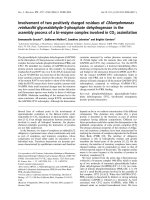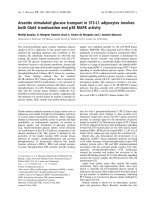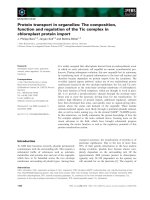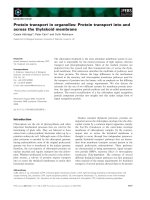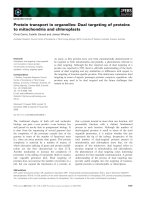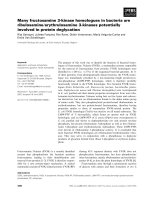3 rail transport in 21 century
Bạn đang xem bản rút gọn của tài liệu. Xem và tải ngay bản đầy đủ của tài liệu tại đây (45.51 KB, 2 trang )
3. Rail Transportation in the 21st Century
Although railways are a product of the industrial revolution, they has been affected by continuous
innovations, technical, regulatory and commercial changes which have improved their capacity and
efficiency. Rail transportation is thus as important in the 21st century as it was in the late 19th century.
One innovation relates to the quality of the rail infrastructure, particularly rail tracks (e.g. better steel,
concrete ties), which will determine the operational characteristics of their use such as speed, permitted
weight, maintenance and resilience to the environment. Increasing electrification and automation will
also improve the efficiency of rail transportation, passenger and freight alike. A few new rail lines are
being built, but mainly in developing countries. Railway speed records have constantly improved with
the introduction of high speed rail systems. For instance, portions of the French high speed rail system
(also known as TGV: Tres Grande Vitesse) can reach speeds up to 515 km/hr. Variable wheel-base axles
permit rail transport between different gauges. However, freight trains run at a considerably lower
speed, in the range of 30-35 km/hr. In some cases, as the rail system gets more used, operational speed
may decline because of congestion. Longer and heavier rail coupled with major engineering
achievements allow the suppression of natural obstacles, which enhance network continuity. The Seikan
tunnel between the islands of Honshu and Hokkaido in Japan has a length of 53.8 kilometers while the
Channel tunnel between France and England reaches 50.5 kilometers. One of the most technically
challenging rail segment ever built was completed in 2006 in China. The 1,142 kilometers line links
Golmud in Qinghai province to Lhasa in Tibet. Some parts go through permafrost and altitudes of 16,000
feet, conferring its status of the world's highest rail line. Rail transport has comparative advantages in
carrying heavy bulk traffic on specific itineraries over long distances. For instance, a 10 car freight train
can carry as much cargo as 600 trucks. Beside its emphasis on safety and reliability, rail transport favors
the fast commuting of suburbanites during peak hours and has become an important mode supporting
passenger movements in large cities. The global trend involves the closure of unprofitable lines as well as
the elimination of several stops. Over the last 50 years, with downsizing of rail transportation, while
traffic was moving to other modes, rail companies abandoned lines (or sold them to local rail
companies), removed excess terminals and warehousing capacity and sold off property. The process of
rationalization (deregulation) of the rail network is now completed in a number of countries, such as in
the United States. This has implied significant labor savings with the reduction of train crews (from 3-4 to
2), more flexible working hours and the usage of subcontractors for construction and maintenance. In
addition to energy efficient (the fuel efficiency of locomotives has increased by 68% between 1980 and
2000) and lighter equipment, the usage of double-stack cars has revolutionized rail transportation with
additional fuel efficiency and cost reductions of about 40%. Depending on the service and type of
commodity carried rail can be 1.9 to 5.5 more energy efficient than trucking. Unit trains, carrying one
commodity-type only, allow scale economies and efficiencies in bulk shipments, and double stacking has
greatly promoted the advantages of rail for container shipments. Trends concerning cargo transport
using trailers on flat cars (TOFC) and containers on flat cars (COFC) well illustrate the increasing
adoption of intermodal transport. Still, TOFC services are being phased down and COFC increasingly
dominates. An active market for niche services such as Roadrailers mounting truck trailers as train
convoys remains. Due to its great versatility, the container is highly favored as such a means of cargo
transport; loading trailers unto rail cars is prone to inefficiencies, particularly a much lower load factor
than containers. Double-stack rail technology is a major challenge for the rail transport system as it is
effective for long distances where additional terminal costs are compensated by lower transport costs.
North America has a notable advantage over Europe on this issue since a full double-stacked unit train
can carry between 400 and 600 TEU (200 to 300 containers) and can have a length exceeding 10,000 feet
(about 3,000 meters). The average intermodal train length in the United States is around 6,500 feet
(about 2,000 meters). European trains are generally limited to 750 meters and can carry 80 TEU of single
stacked containers while some rail segments can accommodate 850 meters. Further, most railroads were
constructed early in the 20th century and have an overhead clearance that is inadequate for the usage of
double-stack trains. This is notably the case for tunnels and bridges. Even if improving clearance is a
major investment, several rail companies, notably in North America, have invested massively on doublestacking projects. The economies and improved capacity of double-stacking have justified investments of
raising the clearance from 5.33 meters (17’6") to 8.1 meters (20’6") along major long distance rail
corridors. Europe is less advanced in this process because most of its rail facilities were built in the
middle of the 19th century. Clearance thus forbids the usage of double-stacking on most European rail
corridors. The emergence of high-speed rail networks and increasing rail speed had significant impacts
on passengers transportation, especially in Europe and Japan (high speed freight trains are not currently
being considered; see Application 1 for a more detailed overview). For instance, the French TGV has an
operational speed of about 300 km/h. High-speed passenger trains require special lines, but can also use
the existing lines at a lower speed. In many cases it permitted a separation between rail passenger traffic
rolling at high speed and freight traffic using the conventional rail network. The efficiency of both the
passengers and freight rail network was thus improved significantly. Since high-speed trains require
some time to accelerate and decelerate, the average distance between stations has increased
significantly, by-passing several centers of less importance. Over average distances, they have proved to
be able to compete effectively with air transportation. Other strategies include improving the speed of
existing passenger services without building a high speed corridor. This involves upgrading the
equipment and improving the infrastructure at specific locations along the corridor. The benefits of
offering a passenger rail service about 120 km/h can be substantial to improve the quality and efficiency
of inter-city services in high density urban regions.
